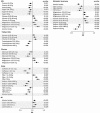Link of dietary patterns with metabolic syndrome: analysis of the National Health and Nutrition Examination Survey
- PMID: 28319105
- PMCID: PMC5380894
- DOI: 10.1038/nutd.2017.11
Link of dietary patterns with metabolic syndrome: analysis of the National Health and Nutrition Examination Survey
Abstract
Background: Population-based interventions aimed at halting the increasing prevalence of metabolic syndrome (MetS) require thorough understanding of dietary interplays. Objective is to identify the independent dietary nutrients associated with MetS and its components using dietary pattern identification and the single-nutrient approaches in The United States.
Methods: This is a cross-sectional observation. Participants are selected from the National Health and Nutrition Examination Survey (NHANES) with available dietary intake, biochemical and anthropometrical data from 2001 to 2012. Exposure is diet obtained from 24-h dietary recall. Main outcome measure is MetS and its components.
Results: Overall, 23 157 eligible individuals including 6561 with MetS were included in the final analysis. Using principle component analysis, we identified three food patterns that explained 50.8% of the variance of the dietary nutrient consumption. The highest quartile of the factor score representative of saturated/monounsaturated fatty acids or the first dietary pattern was associated with 1.27-fold (95% confidence interval (CI): 1.10-1.46, P=0.001) higher odds of association with MetS when compared with the first quartile. The second pattern representative of vitamins and trace elements had an odds ratio of 0.79 (95% CI: 0.70-0.89, P<0.001) for association with MetS, and the third pattern representative of polyunsaturated fatty acids did not have any association with MetS. The nutrient-by-nutrient approach showed that mild alcohol intake and lower consumption of total saturated fatty acids and sodium were associated with lower risk of MetS.
Conclusions: Application of multiple complementary analytic approaches reveals more comprehensive dietary determinants of MetS and its components as potential intervening targets.
Conflict of interest statement
The authors declare no conflict of interest.
Figures


Similar articles
-
Dietary phylloquinone intakes and metabolic syndrome in US young adults.J Am Coll Nutr. 2009 Aug;28(4):369-79. doi: 10.1080/07315724.2009.10718099. J Am Coll Nutr. 2009. PMID: 20368375
-
The association of dietary patterns and adherence to WHO healthy diet with metabolic syndrome in children and adolescents: Tehran lipid and glucose study.BMC Public Health. 2019 Nov 6;19(1):1457. doi: 10.1186/s12889-019-7779-9. BMC Public Health. 2019. PMID: 31694610 Free PMC article.
-
Diet-derived nutrient patterns and components of metabolic syndrome: a cross-sectional community- based study.BMC Endocr Disord. 2020 May 19;20(1):69. doi: 10.1186/s12902-020-0547-0. BMC Endocr Disord. 2020. PMID: 32429966 Free PMC article.
-
Dietary Patterns and Metabolic Syndrome in Adult Subjects: A Systematic Review and Meta-Analysis.Nutrients. 2019 Sep 2;11(9):2056. doi: 10.3390/nu11092056. Nutrients. 2019. PMID: 31480732 Free PMC article.
-
Diet Quality, Saturated Fat and Metabolic Syndrome.Nutrients. 2020 Oct 22;12(11):3232. doi: 10.3390/nu12113232. Nutrients. 2020. PMID: 33105691 Free PMC article. Review.
Cited by
-
Association between chronic hepatitis B infection and metabolic syndrome.J Diabetes Metab Disord. 2018 Oct 27;17(2):223-232. doi: 10.1007/s40200-018-0364-4. eCollection 2018 Dec. J Diabetes Metab Disord. 2018. PMID: 30918858 Free PMC article.
-
Telomere attrition, kidney function, and prevalent chronic kidney disease in the United States.Oncotarget. 2017 Sep 8;8(46):80175-80181. doi: 10.18632/oncotarget.20706. eCollection 2017 Oct 6. Oncotarget. 2017. PMID: 29113293 Free PMC article.
-
Plasma Saturated and Monounsaturated Fatty Acids in Behçet's Disease.Open Rheumatol J. 2018 Aug 31;12:139-151. doi: 10.2174/1874312901812010139. eCollection 2018. Open Rheumatol J. 2018. PMID: 30258503 Free PMC article.
-
Association between dietary patterns and metabolic syndrome in the selected population of Polish adults-results of the PURE Poland Study.Eur J Public Health. 2019 Apr 1;29(2):335-340. doi: 10.1093/eurpub/cky207. Eur J Public Health. 2019. PMID: 30285088 Free PMC article.
-
Dietary Patterns in Relation to Metabolic Syndrome among Adults in Poland: A Cross-Sectional Study.Nutrients. 2017 Dec 17;9(12):1366. doi: 10.3390/nu9121366. Nutrients. 2017. PMID: 29258212 Free PMC article.
References
-
- Zimmet P, Magliano D, Matsuzawa Y, Alberti G, Shaw J. The metabolic syndrome: a global public health problem and a new definition. J Atheroscler Thromb 2005; 12: 295–300. - PubMed
-
- Wang J, Ruotsalainen S, Moilanen L, Lepisto P, Laakso M, Kuusisto J. The metabolic syndrome predicts cardiovascular mortality: a 13-year follow-up study in elderly non-diabetic Finns. Eur Heart J 2007; 28: 857–864. - PubMed
-
- Ford ES. Prevalence of the metabolic syndrome in US populations. Endocrinol Metab Clin North Am 2004; 33: 333–350. - PubMed
-
- Alkerwi A, Donneau AF, Sauvageot N, Lair ML, Albert A, Guillaume M. Dietary, behavioural and socio-economic determinants of the metabolic syndrome among adults in Luxembourg: findings from the ORISCAV-LUX study. Public Health Nutr 2012; 15: 849–859. - PubMed
Publication types
MeSH terms
Grants and funding
LinkOut - more resources
Full Text Sources
Other Literature Sources
Medical
Molecular Biology Databases

